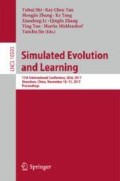Abstract
To improve the effectiveness of commonly used Policy Gradient Search (PGS) algorithms for Reinforcement Learning (RL), many existing works considered the importance of extracting useful state features from raw environment inputs. However, these works only studied the feature extraction process, but the learned features have not been demonstrated to improve reinforcement learning performance. In this paper, we consider NeuroEvolution of Augmenting Topology (NEAT) for automated feature extraction, as it can evolve Neural Networks with suitable topologies that can help extract useful features. Following this idea, we develop a new algorithm called NEAT with Regular Actor Critic for Policy Gradient Search, which integrates a popular Actor-Critic PGS algorithm (i.e., Regular Actor-Critic) with NEAT based feature extraction. The algorithm manages to learn useful state features as well as good policies to tackle complex RL problems. The results on benchmark problems confirm that our proposed algorithm is significantly more effective than NEAT in terms of learning performance, and that the learned features by our proposed algorithm on one learning problem can maintain the effectiveness while it is used with RAC on another related learning problem.
Access this chapter
Tax calculation will be finalised at checkout
Purchases are for personal use only
References
Balduzzi, D., Frean, M., Leary, L., Lewis, J.P.: The shattered gradients problem: if resnets are the answer, then what is the question? arXiv.org (2017)
Bengio, Y., Courville, A., Vincent, P.: Representation learning: a review and new perspectives. IEEE Trans. Pattern Anal. Mach. Intell. 35(8), 1798–1828 (2013)
Bhatnagar, S., Sutton, R.S., Ghavamzadeh, M., Lee, M.: Natural actor-critic algorithms. Automatica 45(11), 2471–2482 (2009)
Chen, G., Douch, C.I.J., Zhang, M.: Accuracy-based learning classifier systems for multistep reinforcement learning: a fuzzy logic approach to handling continuous inputs and learning continuous actions. IEEE Trans. Evol. Comput. 20(6), 953–971 (2016)
Deisenroth, M.P., Neumann, G., Peters, J.: A survey on policy search for robotics. Found. Trends Robot. 2(1–2), 1–142 (2013)
Castro, D., Mannor, S.: Adaptive bases for reinforcement learning. In: Balcázar, J.L., Bonchi, F., Gionis, A., Sebag, M. (eds.) ECML PKDD 2010. LNCS (LNAI), vol. 6321, pp. 312–327. Springer, Heidelberg (2010). doi:10.1007/978-3-642-15880-3_26
Grondman, I., Busoniu, L., Lopes, G.A.D., Babuška, R.: A survey of actor-critic reinforcement learning: standard and natural policy gradients. IEEE Trans. Syst. Man Cybern. Part C Appl. Rev. 42(6), 1291–1307 (2012)
Gu, S., Lillicrap, T.P., Sutskever, I., Levine, S.: Continuous deep q-learning with model-based acceleration. In: ICML, pp. 2829–2838 (2016)
Hermundstad, A.M., Brown, K.S., Bassett, D.S., Carlson, J.M.: Learning, memory, and the role of neural network architecture. PLoS Comput. Biol. 7(6), e1002063 (2011)
Kamio, S., Iba, H.: Adaptation technique for integrating genetic programming and reinforcement learning for real robots. IEEE Trans. Evol. Comput. 9(3), 318–333 (2005)
Konidaris, G., Osentoski, S., Thomas, P.: Value function approximation in reinforcement learning using the fourier basis. In: 2011 AAAI, pp. 380–385 (2011)
Lanzi, P.L.: Learning classifier systems: then and now. Evol. Intell. 1(1), 63–82 (2008)
Loscalzo, S., Wright, R., Yu, L.: Predictive feature selection for genetic policy search. AAMAS 2014, 1–33 (2014)
Menache, I., Mannor, S., Shimkin, N.: Basis function adaptation in temporal difference reinforcement learning. Ann. Oper. Res. 134(1), 215–238 (2005)
Parr, R., Painter-Wakefield, C., Li, L.: Analyzing feature generation for value-function approximation. In: ICML, pp. 737–744 (2007)
Peng, Y., Chen, G., Zhang, M., Pang, S.: A sandpile model for reliable actor-critic reinforcement learning. In: IJCNN, pp. 4014–4021. IEEE (2017)
Peng, Y., Chen, G., Zhang, M., Pang, S.: Generalized compatible function approximation for policy gradient search. In: Hirose, A., Ozawa, S., Doya, K., Ikeda, K., Lee, M., Liu, D. (eds.) ICONIP 2016. LNCS, vol. 9947, pp. 615–622. Springer, Cham (2016). doi:10.1007/978-3-319-46687-3_68
Schrum, J., Miikkulainen, R.: Discovering multimodal behavior in ms. pac-man through evolution of modular neural networks. IEEE Trans. Comput. Intell. AI Games 8(1), 67–81 (2016)
Stanley, K.O., Miikkulainen, R.: Evolving neural network through augmenting topologies. Evol. Comput. 10(2), 99–127 (2002)
Sutton, R.S., Barto, A.G.: Reinforcement learning: An introduction, vol. 1. MIT press, Cambridge (1998)
Sutton, R.S., Mcallester, D., Singh, S., Mansour, Y.: Policy gradient methods for reinforcement learning with function approximation. In: NIPS, pp. 1057–1063 (1999)
Whiteson, S., Stone, P.: Evolutionary function approximation for reinforcement learning. J. Mach. Learn. Res. 7(5), 877–917 (2006)
Whiteson, S., Stone, P., Stanley, K.O., Miikkulainen, R., Kohl, N.: Automatic feature selection in neuroevolution. In: 2005 GECCO, pp. 1225–1232 (2005)
Author information
Authors and Affiliations
Corresponding author
Editor information
Editors and Affiliations
Rights and permissions
Copyright information
© 2017 Springer International Publishing AG
About this paper
Cite this paper
Peng, Y., Chen, G., Zhang, M., Mei, Y. (2017). Effective Policy Gradient Search for Reinforcement Learning Through NEAT Based Feature Extraction. In: Shi, Y., et al. Simulated Evolution and Learning. SEAL 2017. Lecture Notes in Computer Science(), vol 10593. Springer, Cham. https://doi.org/10.1007/978-3-319-68759-9_39
Download citation
DOI: https://doi.org/10.1007/978-3-319-68759-9_39
Published:
Publisher Name: Springer, Cham
Print ISBN: 978-3-319-68758-2
Online ISBN: 978-3-319-68759-9
eBook Packages: Computer ScienceComputer Science (R0)

